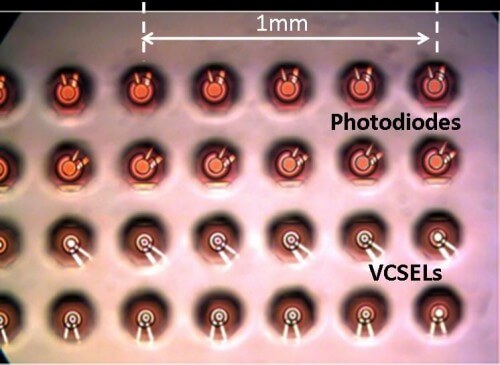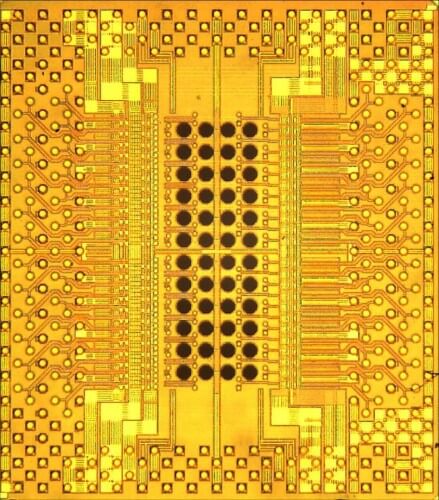With such a speed, it will be possible to download videos from the Internet in a few seconds or, for example, the entire Library of Congress in the USA in less than an hour

IBM is developing a parallel optical chip, capable of transferring a trillion bits of data (one terabit) per second using the power of light.
Scientists at IBM have revealed an innovative development that speeds up the work rate of the well-known optical communication technology and allows one bit of data to be streamed on a chip the size of which is smaller than a one-shekel coin.
A report on the new development was presented by IBM researchers at the fiber optic communication conference in Los Angeles.
The new chip, dubbed the Holey Optochip - "holey optical chip" - operates at a speed eight times higher than that of parallel optical components available today, and may bring about a revolution in the way data is accessed and shared. The raw speed of such a communication component is equivalent, for example, to the bandwidth consumed by 100,000 users on a high-speed Internet connection at a speed of 10 megabits per second.
To illustrate the unimaginable speed of data transfer, IBM researchers stated that at such a speed it would be possible to transfer the entire contents of the American Congress library in less than an hour, or hundreds of videos in a few seconds.
The progress of the field of optical communication is accelerating today, in view of the high demands of new applications and services that rely on increasing amounts of information created and transmitted in business networks and for use by end consumers. Optical networks offer the potential for a significant improvement in the rate of data transmission, thanks to the use of light signals for the purpose of transmitting the bits of information - instead of electrons moving on wires. Researchers and developers are currently looking for new ways to produce optical communication chips at a low price and in large quantities.
The innovative method developed in IBM's research laboratories uses silicon and standard CMOS technology - in order to drill 48 tiny holes in each chip. These tiny holes allow access of optical signals through the back of the chip (the top part, not connected to the motherboard). Thus, it is possible to connect 24 incoming reception channels and 24 outgoing transmission channels to a chip the size of a one shekel coin - and achieve record performance.
IBM's new optical chip is built from components and manufacturing technologies that are all available on a commercial basis, in a way that allows it to be manufactured while maximizing the advantages of size.

The perforated optical chip also records records when it comes to the efficiency of current use - and is faithful to the principles of green computing. It consumes less than 5 watts - so the current consumption of 20 such chips is equal to that of one 100 watt incandescent light bulb.
The parallel optical communication technology, on which the new IBM chip is based, is an optical fiber channel technology designed for communication with a particularly high volume of data for short distances, of less than 150 meters. Parallel optical communication differs from serial communication of a double optical fiber, thanks to its ability to simultaneously transmit and receive data over a large number of fibers.

9 תגובות
For the power collector (W - watt - the amount of energy invested) is a multiple of the voltage (V - volt - the pressure of the electrons in the conductor) in the current (A - ampere - the amount of electrons in the conductor). 1 watt is equal to one volt times one ampere. Therefore, it is possible to compare watts even when it comes to different voltages, or different strength of currents.
How is it possible that 20 chips consume the same current as a 100W light bulb? According to my understanding, a motherboard operates at 12V and a lamp at 220V, therefore the current consumption is completely different.
Researchers at IBM have developed a technology
IBM develops a parallel optical chip,
Not sure what stage they are at?
Mickey – the reason you are stuck at 60MBps is that the bottleneck on a PC with a 1GB network card is usually the storage system (there are other factors that reduce the actual bandwidth but this is the main one by a considerable margin).
The hard disk and the controller in most personal computers (if bought in the last two or three years) provide a theoretical bandwidth of 300MBps through a controller in the SATA2 standard - in practice if you get a third of that in real use it is excellent (say copying between computers in a back to back connection) so that MBps60 or 480Mbps Very beautiful (relative to most personal computers).
There is a nice software called JPERF that allows copying not from the disk to the RAM so that the bottleneck goes (not in all cases, but usually) to the network card and then you may see about 120MBps which is almost 1Gbps (the utilization of the packet transmission method - what is called The overhead of IP/ethernet - these do not allow reaching the full 125MBps that is theoretically possible).
Another option is to purchase SSD disks for both computers - a strong (and expensive) SSD disk provides about 400MBps or 3.2Gbps which is of course far beyond the capacity of the network card.
It is quite clear that there is always the bottleneck, but this is a big step forward and one can only imagine the possibilities that such data speed can bring with it.
I estimate that the initial applications will be applications in "heavy" systems and not in the Internet itself except for critical sections of it.
Such data transfer speed can be significant in analyzing the results of particle accelerators or telescopes for example
Mickey, maybe this is happening to you because the router is not 1 gigabit
Uri, you are right, this is about the implementation of the transmitter and the receiver, but the infrastructure is the one that will ultimately determine the speed. What is certain is that the connectors need 48 optical fibers.
The Ethernet infrastructure today is 1GigaBit and we are really not even close to utilizing this speed (even with connecting two computers directly to each other), which means a theoretical connection speed of 128MB per second. I was able to reach a maximum of maybe 60MB per second and that too only at the beginning of the transfer.
Components of this type are intended for very powerful communication servers - such as, for example, in the stock market and for companies that predict the next millisecond, which need a very fast connection to the stock market servers...
The power of light?
You must call yourself a physicist
On the one hand, congratulations on the technological achievement!
But I don't understand how it will help us if it is only effective for such short distances of 150 meters? How will it help with the internet speed that is intercontinental at distances of tens of thousands of kilometers?